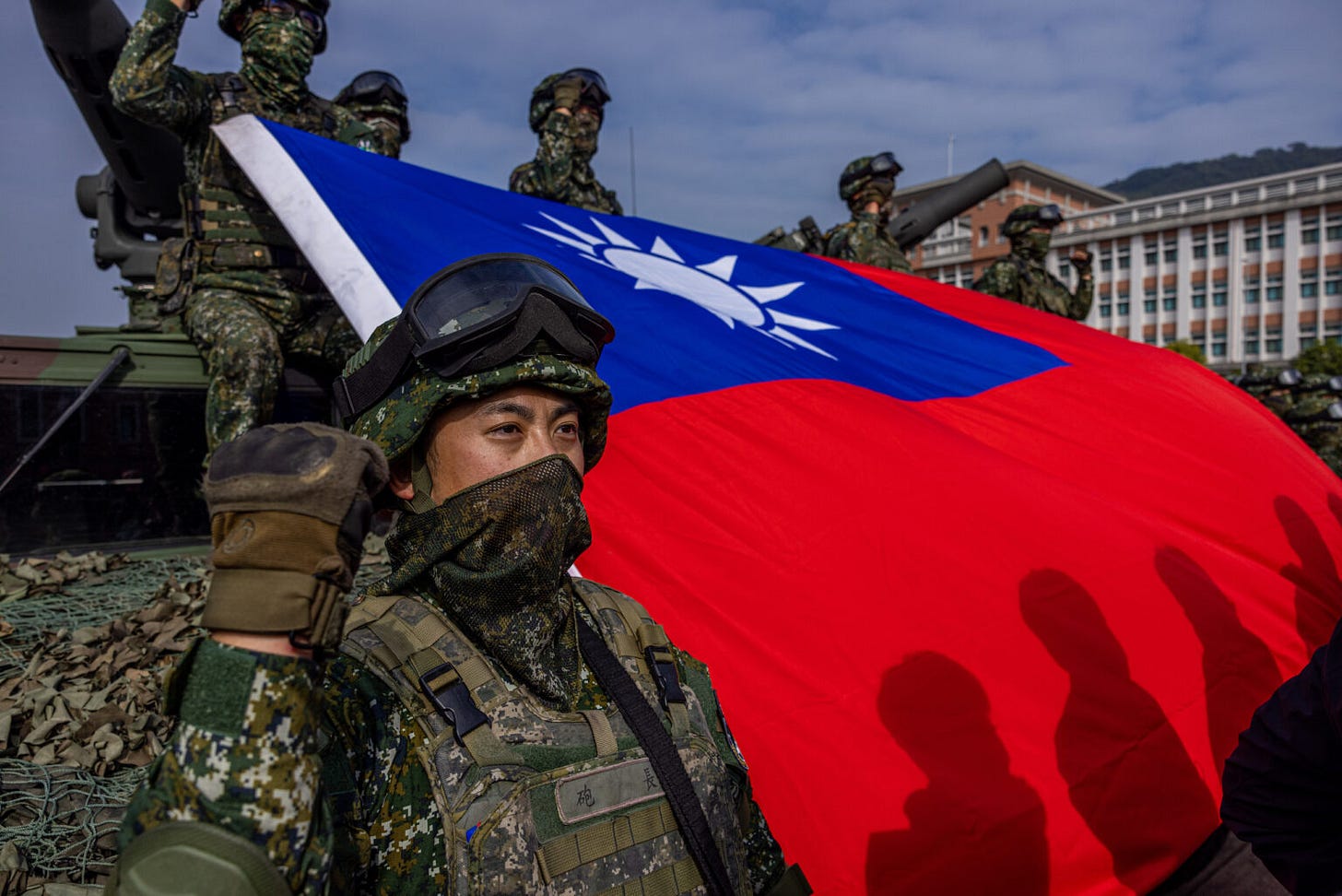Taiwan Says We'll Shoot at Intruding Forces
Defense minister reiterates aggressive policy
By: Jens Kastner
Cornered by China’s increasingly aggressive salami-slicing tactics, Taiwan’s defense ministry last week reminded China that it will fire at intruding People's Liberation Army (PLA) forces even if they don’t fire first, a repetition by Taiwan’s defense minister Chiu Kuo-cheng of a doctrine first enunciated by Chiu in October 2022, when he said the Taiwan military would view any crossing of aircraft or vessels as a first strike.
Chiu’s statement is concerning because Taiwan is regarded as having no other options, given the rapid expansion of Chinese "gray zone" tactics against its territorial integrity. Since 2020, the island has recorded increasingly frequent PLA incursions into its Air Defense Identification Zone (ADIZ) and crossing of the Taiwan Strait median line by large, combat-credible groupings of fighters, bombers, and reconnaissance and electronic warfare aircraft. Affairs reached a new stage of intensity in late January when the Chinese Civil Aviation Administration unilaterally announced flight path adjustments that would bring commercial airliners closer to the median line. Pushing the boundaries even further, China's coast guard in late February boarded and checked a Taiwanese tourist boat in Taiwan-controlled waters near the frontline Kinmen islands following the drowning of two Chinese fishermen after their boats capsized when chased by Taiwan’s coast guard in the same area.
This arc of developments closely resembles those in the South China Sea’s Second Thomas Shoal, where China’s gray-zone tactics are rapidly eroding the Philippines’ control of contested waters. On March 5, the Philippines accused China of disrupting its mission to resupply troops stationed on the BRP Sierra Madre, a grounded warship, by ramming Philippine supply boats and shooting water cannons at them, injuring four people on board.
“In the past, only when the enemy had fired a first shot would the armed forces counter, but now the military would engage following a ‘first move’ that involves PLA aircraft or vessels ‘crossing the boundary,’ Chiu said during the March 7 legislative hearing. Although Chiu did not specify what the boundary meant, he said during previous legislative hearings that it referred to the boundary delineating Taiwan's territorial waters and airspace.
That followed Taiwan in August 2022 authorizing more relaxed rules of engagement against unmanned aerial vehicles, or drones, and deploying anti-drone electronic warfare weaponry after a Chinese UAV model harassed Taiwanese garrison troops stationed on Kinmen, the cluster of islets occupied by Taiwan troops a bare 2 km from the mainland. China’s psychological warfare campaign scored a big win from that incident, as footage of the Taiwanese soldiers helplessly throwing rocks at the device was heavily ridiculed in both Chinese and Taiwanese media and social media.
Analysts speaking to Asia Sentinel see the change of doctrine as highlighting worry by Taiwanese authorities that if People’s Liberation Army troops and materiel continue to encroach on Taiwan’s air and maritime space, at some point they could deploy a large force in Taiwan’s waters that then suddenly attacks.
“The new posture announced by Defense Minister Chiu Kuo-cheng seems bold since the Ministry of Defense for so long has worried about giving China a pretext to take aggressive action, but Taipei seems to have concluded that it needs to signal to Beijing that there is a limit to how much gray-zone warfare Taiwan will tolerate,” said Denny Roy, an expert on Taiwan’s political history and a senior fellow at the US-based East-West Center think tank. “It's important for Taiwan to prevent China from routinely operating so close to Taiwan that the ROC armed forces would have no warning before realizing that what looks like an exercise or a patrol is actually an attack.”
Similarly, Timothy R. Heath, Senior International Defense Researcher at RAND Corporation, pointed out that keeping Chinese forces at bay makes it more difficult for the Chinese leaders to develop options in which it carries out military ‘exercises’ in Taiwan’s waters that suddenly turn into an attack. “This is primarily a deterrent move, warning Chinese leaders against assuming that they can occupy Taiwan’s air and maritime space without risk,” Heath said.
Nevertheless, Wendell Minnick, a Taipei-based military analyst, believes that defense minister Chiu’s statement should be taken with a pinch of salt, given that policy is made by the Presidental National Security Council (NSC) rather than the defense ministry.
“The PLA fighters have been painting Taiwan fighters with their target radar lock for years, but it is the policy to not reciprocate unless they fire first, reducing the chance of someone on the Taiwan side starting a war,” Minnick said.
Meanwhile, the Philippines seems far from following Taiwan’s precedent in changing the military’s rules of engagement. Speaking on condition of anonymity, a retired rear admiral of the Philippine Navy stressed in a conversation with Asia Sentinel that “any foreign warship transiting the territorial seas of any coastal state enjoys freedom of navigation unless it commits acts stipulated under Article 19 of UNCLOS [United Nations Convention on the Law of the Sea].” Passage is considered innocent so long as it is not prejudicial to the peace, good order, or security of the coastal state. Among the prejudicial activities listed are exercises with weapons; collection of information; spreading propaganda; and loading or unloading of any commodity, currency or person contrary to the customs, fiscal, immigration or sanitary laws and regulations of the coastal state.
Despite that ruling, Chinese PLA Coast Guard vessels continue to swarm Filipino ones, most recently last week, contributing to sharpy growing tension. Nonetheless, the Chinese Foreign Ministry continues to claim that China has never harassed the Philippines.

